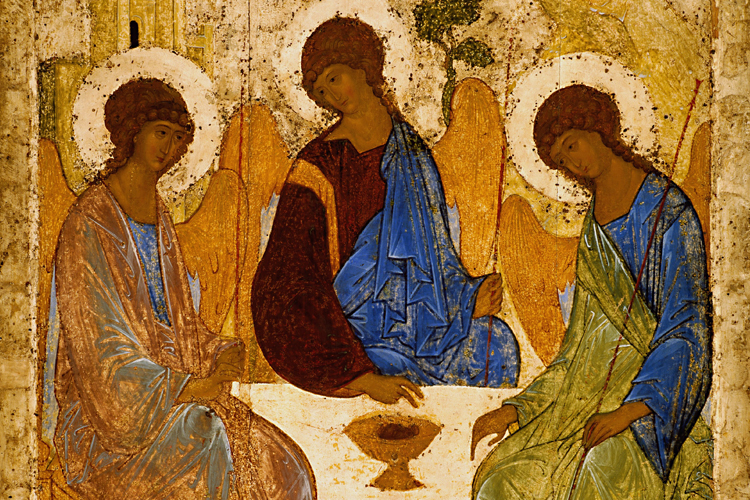
21 Apr Trinity and LEADiscipleship
Trinity and LEADiscipleship
Leading and being led in the image of the triune God
By K. Lindsay Oaks
(North America Regional CEO, The HuD Group)
LEADiscipleship Review
As a subtitle for our ‘LEADiscipleship’ theme for The HuD Group’s 20th anniversary year, we have the following: becoming a fuller fisher, friend and follower of Jesus Christ (HuD Group, 2023).
We have defined a disciple as “a person (or entity) who through the Holy Spirit is continually pursuing intimacy with the Father, imitating Jesus Christ and influencing others to do likewise, all in response to the loving call of God” (HuD Group, 2023).
Already, one can see in our definition of a disciple, trinitarian language:
- A disciple pursues intimacy with God the Father
- A disciple imitates Jesus Christ
- A disciple is guided and empowered by the Holy Spirit in the above and to influence others.
Why is the Trinity so important in LEADischipleship?
If we are to lead like God and the essence of discipleship is to become and behave like God, in whose image and likeness we were first created (Genesis 1:26-27) and fell from (Romans 3:23), then we had better know what this God really is like in the first place. How can we become and behave–whether in leadership or discipleship–like someone we have no clue about or don’t know well enough?
And as we also see from the above definition of a disciple, although all three are inseparably related (in fact, one) and each person of the Trinity feeds into what the other does in our discipleship, each person also takes the lead on behalf of the entire Godhead in any particular activity or component of our discipleship: intimacy (Father), imitation (Jesus), influence (Spirit). We will soon see another example of this in the parts played in our salvation itself.
Trinity and LEADiscipleship: The Understanding
Why is the Trinity so difficult to understand?
The notion of God as Trinity is the foundation of all Christian thought, and yet we frequently dismiss the Trinity because it is so difficult to understand (Rohr, 2022). We have dualistic minds and the trinity is not dualistic.
- Think of the number TWO – when there are two things, they are always in competition with one another. Dualism has to compare and one side is higher and one side is lower.
- Now think of the number THREE—the principle of three is always dynamic, it keeps you moving and flowing (Rohr, 2021). The principle of the Trinity was made to defeat the dualistic mind. God is not one, God is not two, God is three.
Explanation of the Trinity
- God is formlessness (the Father)
- God is form (the Son)
- and God is the very living and loving energy between those two (the Holy Spirit).
The three do not cancel one another out. Instead, they do exactly the opposite. They move in a reciprocal relationship with each other: giving and taking.
“The Trinity reveals God more as a verb than a noun. God is three “relations,” which itself is mind-boggling for most believers. God is dynamic—a verb rather than a static name” (Rohr, 2023).
Seeing the Trinity in Scripture
Once we begin to look for the Trinity in Scripture, we find the Father, Son and the Spirit on almost every page of the Bible. Even on the very first page, and in the very first verses of Scripture.
Genesis 1:1-3
1. “In the beginning, God created…”
- Elohim in Hebrew is the word for God in this phrase and is a PLURAL noun. This raises the question, in the beginning were there many gods??
- Bara in Hebrew is the word to create, to make something out of nothing. Therefore, in this plural noun, God, we see God as creator in Genesis 1:1
2. “In the beginning, God created the heavens and the earth. The earth was formless and empty, and darkness covered the deep waters. And the Spirit of God was hovering over the surface of the waters” (Gen. 1:1-2). In verse 2, we see God as a Spirit hovering.
3. “In the beginning, God created the heavens and the earth…the Spirit of God was hovering over the waters. Then God said…” In verse 3, we see God as a word. Who is the word? In John 1:1 we read, “In the beginning was the Word. The Word was with God, and the word WAS God.” The John goes ahead to call the word a person in the next couple of verses. “2 He was with God in the beginning. 3 Through him all things were made; without him nothing was made that has been made” (John 1:2-3). And in case one is still in doubt that this Word is Jesus as God, verse 14 nails it: – and the Word became human and made his home among us” The Word became flesh [human] and made his dwelling [home] among us. We have seen his glory, the glory of the one and only Son, who came from the Father, full of grace and truth.”
What was the word that God said? “LIGHT!” And there was light! As if the undeniable connection between Genesis 1 and John 1 wasn’t awesome enough already, not only is Jesus the Son the Word that was spoken, he is simultaneously the light that emanated. Again in the same John 1 text, “4 In him was life, and that life was the light of all mankind. 5 The light shines in the darkness [the darkness in Genesis 1:1], and the darkness has not overcome it.” Jesus himself later opened his mouth to say, “I am the light of the world” (John 8:12). He added the connection between him as light and him as life: “Whoever follows me will never walk in darkness, but will have the light of life.”So the Word is … Jesus. The Light is… Jesus! Remember that this light in Genesis 1:3 on the first day of creation was not the sun; the sun wasn’t created until the fourth day (Genesis 1:14-19). Jesus even referred to his presence in the world as “day”: “As long as it is day, we must do the works of him who sent me. Night is coming, when no one can work.” (John 9:4). Jesus is God, there is nothing that is made without Him–the word and the light.
So in the first three verses of the Bible, we see a three yet one being – a TRINITY (Tri + Unity) – God as creator, as spirit, and as word/light.
John
Throughout the entire book of John, Jesus refers to God as Father and refers to the Holy Spirit as the Counselor of Truth, whom he will send to those who want to join the Father in his mission of redeeming the world.
1. The Father, creator
2. The Spirit, counselor (helper)
3. The Son, redeemer (rescuer)
Romans 8:9-11
We see in this passage that Paul interchanges the Father, Son and Holy Spirit in a way that implies their mutual indwelling and participation with one another” (Seamands, 2005, p. 141):
9 You, however, are not in the flesh, but in the Spirit, if indeed the Spirit of God lives in you. If anyone does not have the Spirit of Christ, he does not belong to him. 10 Now if Christ is in you, the body is dead because of sin, but the Spirit gives life because of righteousness. 11 And if the Spirit of him who raised Jesus from the dead lives in you, then he who raised Christ from the dead will also bring your mortal bodies to life through his Spirit who lives in you (CSV, Romans 8:9-11).
Perichoresis or the Divine Dance
All three beings participate in the give/take cycle – they give of themselves – God is SELF-GIVING. They send each other; they receive each other. This is a reciprocal relationship – or reciprocity. The Father gives his Sson, the sSon gives us the Spirit, the Spirit gives us insight from the Father. The Father receives his Son, the Son receives words from his Father and receives help from the Spirit. They are constantly giving/receiving in relationship to each other and to the world—in a rhythmic dance. Which is why the Trinity is also often called the perichoresis – DIVINE DANCE of God.
“Perichoresis conveys a number of ideas: reciprocity, interchange, giving to and receiving from one another, being drawn to one another and contained in the other, interpenetrating one another by drawing life from and pouring life into one another as a fellowship of love” (Seamands, 2005, p. 142).
Fidget Spinner as an analogy
There are a lot of analogies out there–none of which fully explains the Trinity because ultimately it is a divine mystery–but the one I like best is the fidget spinner. Picture a fidget spinner in motion: three distinct corners in static form, but in motion it appears as one.

God is moving – always a work in the give/take cycle. GOD is infinite Love flowing between The Father/Son/Spirit, making unity out of clear diversity.
- Without the Son, there would be no redemption
- Without the Spirit, there would be no church
- Without the Father, there would be no life.
We have to have all three. God is three – yet God is one. God is relational. It is his nature and cannot be changed – therefore, God can’t do life alone.
Trinity and LEADiscipleship: The Practice
So where do we come into the picture?
Identity & Community
Jump back to Genesis 1:
“Then God (ONE) said, “Let us (plural) make human beings in our (plural) image… so God created human beings in his own image… male and female he created them” (vs. 26, 27).
We are created in the very IMAGE of God out of a fully RELATIONAL love. In the Trinity we see that LOVE is a constant/dynamic exchange of self-emptying and refilling, mutual giving and receiving.
Fidget SPINNER: If you look at it in static form, it’s three. If you look at it in dynamic form, it’s one. We mirror that love – we have THIS planted inside of us. That’s why we are made for relational love. That’s biblically WHY we can’t do life alone.
Diversity & Unity
Answering the one and the many: How to protect diversity while also protecting radical unity.
Like the trinity, how can something be one and also many? Our definition of love holds the truths together: the Father, the Son, the Spirit to be individual and also one.
God celebrates diversity; God desires unity. How do we put diversity with absolute unity? How do we not simply tolerate diversity, but celebrate diversity while also striving for unity? Using the analogy of a fidget spinner, take what looks like diversity, put it in a wheel of infinite love. “The infinity unites the diversity so perfectly together that you have absolute unity. What looks like three is one” (Rohr, 2017).
Missio Dei, a Trinitarian Mission
God the Father sends his Son to the world, and the Son sends the Holy Spirit. Mission is the sending nature of God (Sunquist, 2013). Out of the Father and Son’s mutual love for one another, Jesus’ ministry flows (Seamands, 2007).
Our ministry is meant to be an extension of Jesus’ own mission. We are to participate with Christ in his suffering love and ongoing ministry as he offers himself to others through us for the greater glory of God to be revealed (Sunquist, 2013).
“The ministry we have entered into is a ministry of Jesus Christ, to the Father, through the Holy Spirit, for the sake of the church and the world” (Seamands, 2007, p. 20).
The nature of mission is that it is God’s work; the extent of mission is for all creation; the means of mission is Jesus Christ. Mission is not a private affair but it is personal while also communal. It involves a cultural mandate to engage humanity through nations and cultures (Sunquist, 2013).
- The Creator God as sending Father. God is a loving Father who will not let go of his people even when they fall away. As evidenced in Scripture, God is constantly sending (missio), reminding, calling, forgiving, and judging.
- Jesus was sent as the suffering and sacrificing Son. Jesus is the suffering love of God to the world, which is the centerpiece of Christian mission. In other words, “Christian mission is trinitarian, but it pivots around the divine-human person of Jesus Christ” (Sunquist, 2013, p. 201).
- The Holy Spirit is the presence, participation, and power in mission. The power and effectiveness of Christian mission comes through the Holy Spirit. The Holy Spirit is the “active agent” who works both with power and personality: he is the power of the creator God and he is the Spirit of the living Christ (Sunquist, 2013).
Conclusion: Back to LEADiscipleship
Our definition of a disciple is “a person (or entity) who through the Holy Spirit is continually pursuing intimacy with the Father, imitating Jesus Christ and influencing others to do likewise, all in response to the loving call of God” (Perbi, 2023).
We are called to join the missio Dei, or the mission of God, as leaders developing disciples to reflect Jesus through the Holy Spirit for the expansion of God’s kingdom and for his glory. Believe, become and behave like Father-Son-Spirit and multiply more of such in the power of the Spirit to the glory of God–a fuller fisher, friend and follower of Jesus Christ.
| FOR THE EAGER BEAVER
Trinitarian theology must be simplified for all as it is the DNA from which all correct Christian thought and right Christian living and leading emanates. To dig deeper into the Trinity (o, there’s so much more), take The HuD Group’s course ‘WWTD–What Will Trinity Do’ online/recorded or at occasional in-person workshops. There are workbooks that go with the two-part class. |
References:
Contemplative Interbeing (Director). (2021, May 5). 10 Richard Rohr Rediscovery of the Trinity. https://www.youtube.com/watch?v=cG6BzyBjRcM
Perbi, Yaw. (2023). LEADiscipleship: Becoming a fuller fisher, friend & follower of Jesus Christ. The HuD Group.
Rohr, R. & Reunion (Director). (2017, December 8). Fr. Richard Rohr – The One and The Many. https://www.youtube.com/watch?v=eGMAbXbRP84
Rohr, R. (2022, January 9). The Mystery of the Trinity. Center for Action and Contemplation. https://cac.org/daily-meditations/the-mystery-of-the-trinity-2022-01-09/
Seamands, S. (2006). Ministry in the Image of God: The Trinitarian Shape of Christian Service. IVP Books.
Sunquist, S. W. (2013). Understanding Christian Mission: Participation in Suffering and Glory. Baker Academic.


No Comments